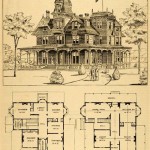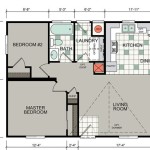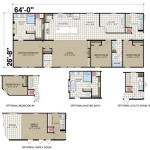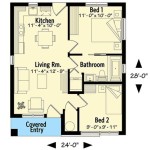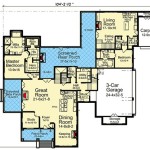Open Floor Plans: A Symbiotic Design for Ranch Style Homes
Ranch style homes, characterized by their single-story layout and sprawling footprint, have enjoyed enduring popularity in American architecture. Their inherent accessibility and informal aesthetic lend themselves well to various lifestyles. A contemporary adaptation that complements the ranch style's inherent strengths is the open floor plan. This design approach, which minimizes interior walls to create a cohesive and expansive living area, aligns perfectly with the ranch home's emphasis on casual living and spaciousness. The fusion of these two elements results in a living environment that fosters connectivity, enhances natural light, and maximizes usable space.
The appeal of open floor plans in ranch style homes stems from several factors, foremost among them being the ability to create a more fluid and interconnected living space. Traditional ranch homes, while often spacious, could sometimes feel compartmentalized due to distinct rooms separated by walls. Removing or minimizing these barriers allows for a seamless transition between the living room, dining area, and kitchen, creating a central hub for family activities and social gatherings. This sense of openness can significantly improve the perceived size of the home, making it feel larger and more inviting.
Furthermore, an open floor plan facilitates better light distribution throughout the home. With fewer walls obstructing the flow of light, natural illumination can penetrate deeper into the interior, reducing the need for artificial lighting during the day. This not only contributes to energy savings but also creates a brighter and more cheerful living environment. The increased visibility also enhances safety, allowing residents to monitor activities in different areas of the home more easily.
However, successful implementation of an open floor plan in a ranch style home requires careful planning and consideration of several key design elements. Without proper attention to these details, the open space can feel disjointed, noisy, and lack definition. Therefore, a thoughtful approach is crucial to achieving the desired aesthetic and functionality.
Defining Spaces within an Open Floor Plan
One of the primary challenges in designing an open floor plan is creating distinct zones within the larger space. Without walls to delineate different areas, it is essential to employ alternative methods to define the function of each zone. This can be achieved through various architectural and design techniques, including changes in flooring, strategic furniture placement, and the use of architectural elements.
Flooring variations can serve as subtle yet effective dividers. For instance, transitioning from hardwood flooring in the living area to tile in the kitchen can visually separate the two spaces without creating a physical barrier. Similarly, using area rugs can define seating arrangements and anchor furniture groupings within the larger open space. The texture and color of the rugs can further contribute to the overall aesthetic and help to distinguish one zone from another.
Furniture placement is another crucial aspect of defining spaces in an open floor plan. Carefully positioning sofas, chairs, and tables can create natural boundaries and delineate conversation areas. For example, a large sectional sofa can serve as a visual barrier between the living room and the dining area, while a kitchen island can define the boundary between the kitchen and the living space. Strategic placement of bookshelves or freestanding cabinets can also contribute to the definition of zones while providing valuable storage.
Architectural elements, such as partial walls, columns, and changes in ceiling height, can also be used to subtly define spaces within an open floor plan. A knee wall or a decorative column can provide a sense of separation without completely closing off the space. Changes in ceiling height, such as a raised ceiling in the living room or a dropped ceiling in the kitchen, can also contribute to the visual definition of different zones. These architectural details can add visual interest and character to the open floor plan while enhancing its functionality.
Managing Noise and Acoustics
One of the potential drawbacks of open floor plans is the increased transmission of noise throughout the home. With fewer walls to absorb sound, noise from the kitchen can easily carry into the living room, and vice versa. This can be particularly problematic in homes with young children or individuals who require a quiet environment for work or study. Therefore, it is essential to implement strategies to mitigate noise and improve acoustics within the open floor plan.
Soft surfaces, such as carpets, rugs, and upholstered furniture, can help to absorb sound and reduce echoes. Incorporating these elements into the design can significantly improve the acoustic environment of the open space. Window treatments, such as drapes or blinds, can also help to absorb sound and reduce noise levels. In addition, acoustic panels can be strategically placed on walls or ceilings to further dampen sound and improve acoustics.
The selection of appliances and equipment can also play a role in noise reduction. Choosing quieter appliances, such as dishwashers and refrigerators, can minimize noise pollution in the kitchen. Similarly, using a range hood with a powerful but quiet fan can help to remove cooking odors and reduce noise levels. Consider the sound ratings of various appliances when making purchasing decisions.
Strategic placement of furniture and fixtures can also help to mitigate noise transmission. For example, positioning a bookshelf or a large cabinet between the kitchen and the living room can act as a sound barrier, reducing the amount of noise that travels between the two spaces. Similarly, locating the laundry room or other noisy areas away from the main living space can help to minimize noise disturbance.
Integrating Storage Solutions
In open floor plans, storage becomes even more crucial to maintain a clutter-free and organized living environment. Without the benefit of separate rooms to conceal belongings, it is essential to incorporate ample and well-designed storage solutions throughout the open space. This can be achieved through a variety of built-in and freestanding storage options.
Built-in storage solutions, such as custom cabinetry, shelving units, and window seats with storage compartments, are particularly effective in maximizing space and minimizing clutter. These built-in elements can be seamlessly integrated into the design of the open floor plan, providing ample storage without sacrificing valuable floor space. Consider incorporating built-in storage in areas such as the living room, dining room, and kitchen to keep belongings organized and out of sight.
Freestanding storage furniture, such as bookshelves, dressers, and cabinets, can also provide valuable storage space in an open floor plan. Choose furniture pieces that complement the overall aesthetic of the home and provide adequate storage for specific items. Consider using storage ottomans or coffee tables with built-in storage to maximize functionality and minimize clutter in the living area.
Vertical storage solutions, such as tall bookshelves and wall-mounted cabinets, can also be effective in maximizing storage space in an open floor plan. These vertical storage elements can take advantage of unused wall space, providing ample storage without taking up valuable floor space. Consider using vertical storage solutions in areas such as the kitchen, pantry, and home office to keep belongings organized and accessible.
The successful integration of an open floor plan into a ranch style home hinges on meticulous planning and thoughtful execution. By carefully considering the definition of spaces, the management of noise, and the integration of storage solutions, homeowners can reap the benefits of a spacious, interconnected, and well-organized living environment that perfectly complements the ranch style's inherent charm and livability.

Trending Ranch Style House Plans With Open Floor Blog Eplans Com

Ranch House Plans With Open Floor Blog Homeplans Com

Open Concept Ranch Floor Plans Houseplans Blog Com

Trending Ranch Style House Plans With Open Floor Blog Eplans Com

Ranch House Plans With Open Floor Blog Homeplans Com

Open Concept Ranch Floor Plans Houseplans Blog Com

Ranch House Plans With Open Floor Blog Homeplans Com

Cool Ranch Style Homes For 2024 Blog Eplans Com

9 Best Open Floor Plans For Ranch Style Homes Deepnot Log Home House

Ranch House Plans With Open Floor Blog Homeplans Com
See Also

